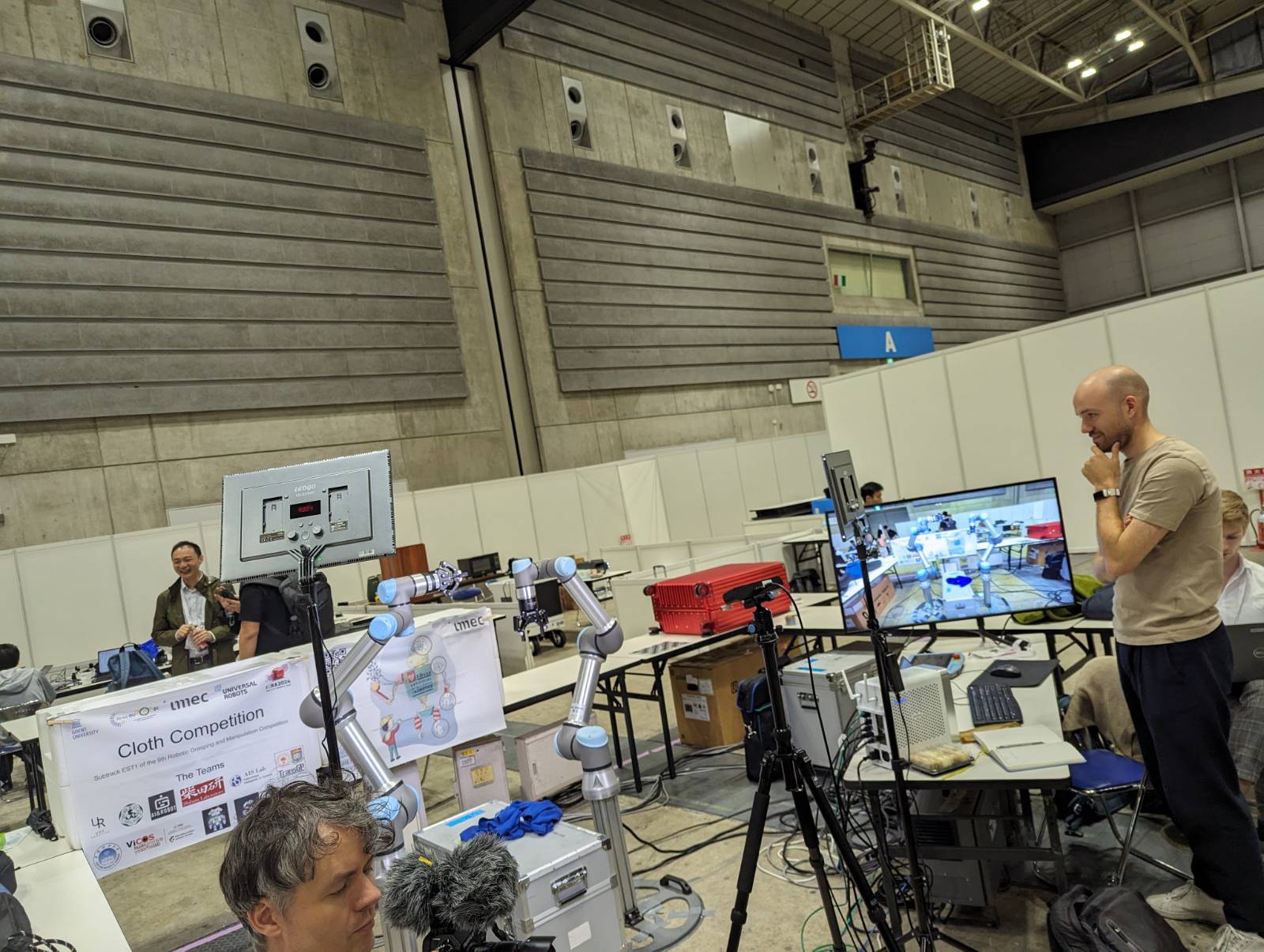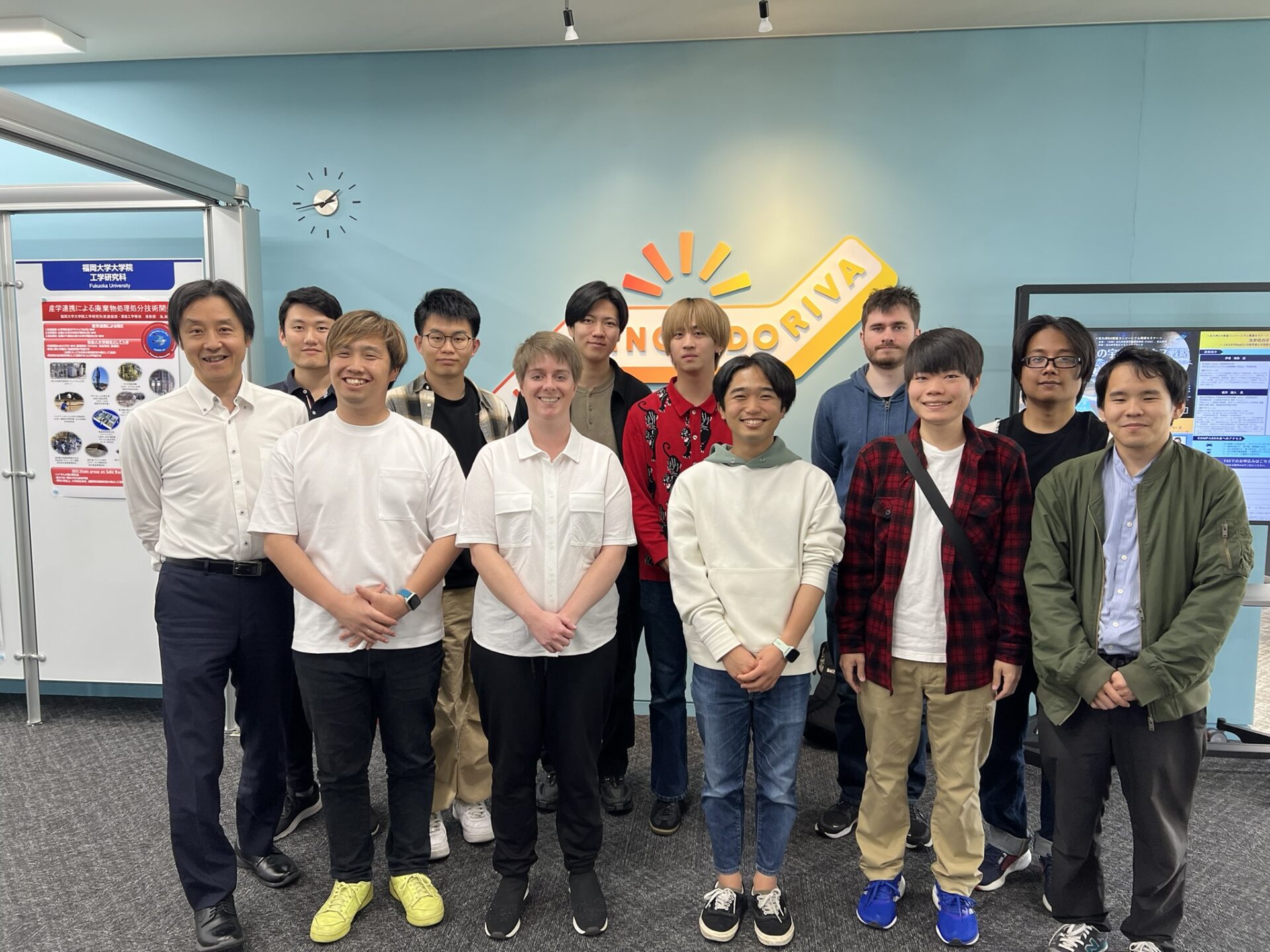Feature Image: A group photo of Christina E. Stimson with Shibata-sensei and his students, taken after she gave a seminar on her work with children with osteogenesis imperfecta and their families.
In May 2024, I had the privilege of fulfilling a life-long dream to visit Japan. This was at the generous invitation of my itDf colleague, Prof. Tomohiro Shibata of the Kyushu Institute of Technology in Kitakyushu, Fukuoka Prefecture. My sojourn lasted three weeks across geographically and culturally-disparate parts of the country; Kitakyushu, Yokohama, Tokyo, and Osaka.
The first week was spent learning from Shibata-sensei’s Rapid Creation Section and Smart Life Care Co-Creation Laboratory. My doctoral research has focused mainly on the use of Participatory Design (PD)—the equitable involvement of all stakeholders in the design of the products and services they use—in the fields of robotics and assistive technology. While PD is gaining traction in these contexts, few studies involve potential end users in a meaningful manner or progress beyond proofs of concept. I was pleased to find that Tom (his preferred name, although I became accustomed to using honorific speech to facilitate his students’ understanding and comfort) and his colleagues do indeed practise what PD preaches.
I enjoyed meeting several people who are directly involved with the PD work at “Kyutech”. Mr. Ryo Ito of the Congenital Myopathy Society explained its collaboration with the Rapid Creation Section, and how local disabled people are taking active agency in both their care and participation in society.

My next meeting was with Mr. Hiroki Sasahara, Paralympic medallist and senior engineer at OMRON Taiyo, a Japanese manufacturer of electrical components that made an ethical commitment to employing disabled people in an equitable manner over 50 years ago, at a time when disability was egregiously pathologised. The company is currently expanding its scope to employ people with intellectual disabilities as well as those with physical ones; this is testament to said ethical commitment and to the company’s commercial success.
A highlight of my visit was Ichoan Nursing Home. A local community centre that also acts as an assisted living facility, it ensures that older people experiencing health issues remain active in the community, and so avoid the isolation and resultant decline in wellbeing and cognitive functioning associated with traditional care homes. I was shown around by the centre’s founder, Ms. Kimie Gondo, whose passion and commitment to her community shone through. Gondo-san’s vision is one of young and old, healthy and unhealthy, and everything in between being in regular social contact in ways that are both physically safe and emotionally gratifying. The centre’s use of LOVOT, a kawaii (cute) robot, is leading the way in improving residents’ physical and cognitive functioning, as well as alleviating both resident and caregiver stress levels. Gondo-san hopes to spread her emancipatory concept throughout Japan; it deserves to go global!

The opportunity of interviewing two local community nurses and one of their patients was particularly illuminating, as it gave me an idea of how Shibata Lab’s PD work is helping health and social care workers in the immediate area, and reinforced the importance of balancing different stakeholders’ needs and expectations. They described their respective experiences of co-designing a smart device to warn when people living with Parkinson’s Disease are about to experience “wearing off”, when the medication prescribed for the condition begins to work less effectively, making movement-related symptoms more noticeable. The difference in priorities and perspectives of the man living with Parkinson’s and his caregivers was palpable, but they worked in harmony with Shibata Lab to produce a prototype with a user-friendly interface that streamlined both the patient’s experience and the administrative workload of the caregiver.
Before I left Fukuoka, I found time to appreciate its culture and cuisine. I visited the majestic Tôchôji Temple, which houses Japan’s tallest wooden sitting Buddha, and observed a cleansing ritual at Kushida Shrine. It was in one of the famous ramen restaurants in the illustrious Hakata Station that I sampled one of my favourite dishes of the trip: the regional speciality, tonkotsu ramen. This traditional noodle soup’s rich broth is made by simmering pork bones over many hours, and features thin slices of subtly sweet pork belly.
By far the most enjoyable evening during my time at Kyutech was spent at a traditional izakaya; the Japanese equivalent of a British pub but with a particular focus on gastronomy. I had a great time getting to know Tom and his students better, as well as savouring the exquisite dishes and springtime sake (Japanese rice wine) prepared for us by the vivacious owner, who insists on being called “Mama” (she certainly lives up to the name!). They probably regretted encouraging me to sing karaoke, as I absolutely butchered the Japanese language attempting the opening theme tune to the seminal Mecha anime Neon Genesis Evangelion! A good night was had by all; kampai (cheers) to Yutaro-san, Kouki-san, Zita-san, Kaji-san, Kakeru-san, and Aoi-san! I would like to extend special thanks to Keiko-san for looking after me, and for taking me to the best French restaurant I’ve ever been to!
Next, I took the Shinkansen (bullet train) to Yokohama, a busy port city about an hour’s travel from Tokyo, to attend the International Conference on Robotics and Automation (ICRA). I presented a poster on my PhD project, ‘Exploring Human-Robot Futures through Participatory Design’, at the Applications and Future Directions of Affective Technologies workshop. The multidisciplinary workshop’s theme was technology in the context of human emotional responses, and featured speakers from a range of disciplines including electrical and mechanical engineering, neuroscience, and Participatory Design. My poster focused on the interim findings of my main study with children with osteogenesis imperfecta and their families: patterns of meaning relating to participants’ affective responses to both the robots involved and the co-designed PD methodology itself. I appreciated the opportunity to hone my public speaking skills, as well as meeting scholars with similar interests and axiological orientations. The diversity of technological innovations and perspectives present throughout the conference was inspiring, and seeded ideas for postdoctoral research I am now planning.

After an intense couple of weeks, it was time to relax. As luck (and some judicious organising) would have it, a few good friends of mine either live in or were also visiting Japan at the same time, and meeting up on the other side of the world was exhilarating. We made our much-anticipated pilgrimage to Akihabara, a Mecca for anime and video game devotees everywhere. The holiday culminated in the Kansai region, where we visited the majestic Osaka Castle, a natural onsen (hot spring), and the RockRock Music Bar, famously frequented by rock and metal royalty, and which proudly sports wall-to-wall photographs of the many bands and artists who have graced it over the years.
I could easily talk ad infinitum about the many transformative experiences I had during my short time in Japan (pretty much everyone who knows me well has already had the displeasure!). I was asked to write a short piece, but I hope this rather verbose post gives at least some idea of the novel and important work happening in Japan’s unique context of a disproportionately ageing population coupled with an animistic outlook. This openness towards the idea of artificial entities having agency means that robots are already beginning to be embraced as a viable aspect of addressing the shortfall in Japan’s health and social care systems. It is the genuinely participatory endeavours of organisations such as Shibata Lab and their community researchers that are paving the way towards healthier, happier technology futures, and I hope that such work will continue to be propagated through intercultural and interdisciplinary collaborations like itDf long into the future.
My deepest thanks to Tom, and to my primary supervisor, Prof. Tony Prescott, for arranging what I can confidently describe as the trip of a lifetime.

